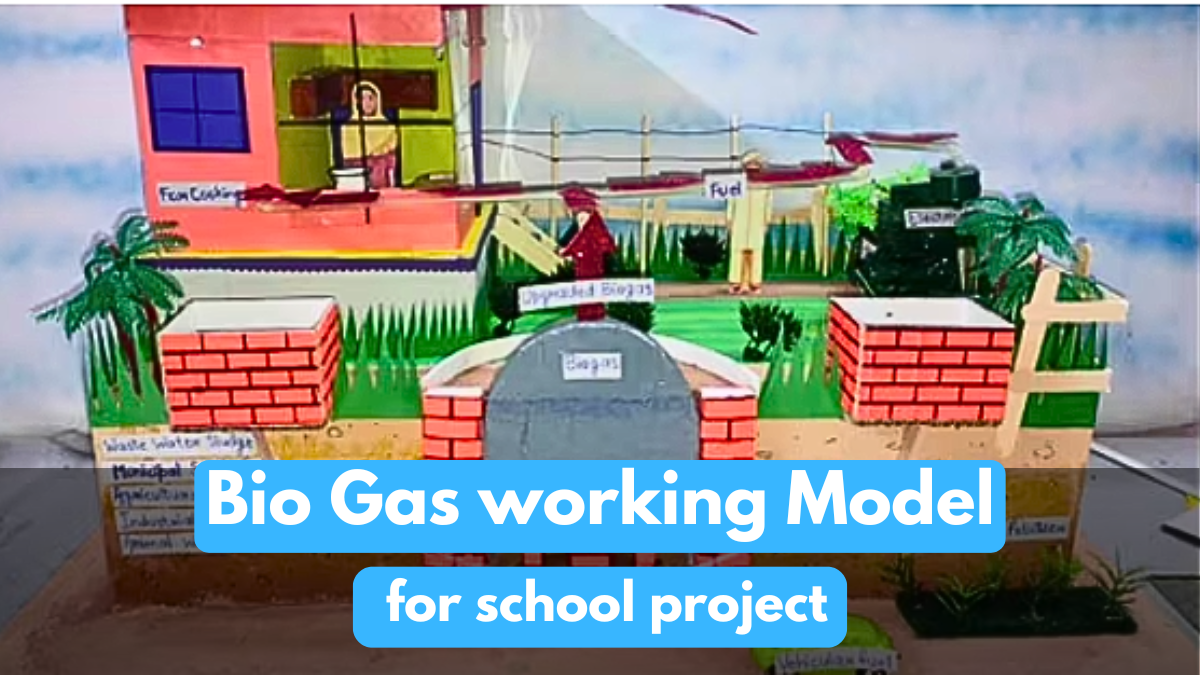Bio gas working model for your school project is a great way to explore renewable energy. Biogas is a clean source of energy produced by the breakdown of organic matter, like food waste, animal dung, and plant materials, in an environment with little to no oxygen.
Materials Required
- Card board
- Thermocol
- Pastel sheet
- Fevicol
- Super glue
- Ohp sheets
- Pipe Water
- Colours
- Markars
Steps to Build Your Biogas 3D Model
Step 1: Prepare the Plastic Bottle
Start by cleaning your plastic bottle. This will be the main container where the organic waste will break down and produce gas.
- Take a small plastic bottle (around 500ml or 1 liter) and remove any labels.
- Use the scissors to cut a small hole in the cap of the bottle. This hole needs to be big enough to fit the plastic tube you will be using to guide the gas into the balloon.
Also Read –Qutub Minar 3D model
Step 2: Insert the Plastic Tube
Next, insert the plastic tube into the hole in the bottle cap.
- Take the plastic tube and cut it to the size that fits into the hole in the bottle cap.
- Secure the tube into the hole with tape to ensure no gas escapes. The other end of the tube should remain free for the balloon attachment.
Step 3: Attach the Balloon
Now, you will attach the balloon to the free end of the plastic tube. This balloon will capture the methane gas produced in the bio gas process.
- Stretch the opening of the balloon and place it over the free end of the plastic tube.
- Secure the balloon in place with a piece of tape if needed. The balloon will expand as the gas is produced in the next steps.
Step 4: Add Organic Waste
Now comes the fun part! You’ll be adding the organic waste, which will start the bio gas process.
- Use a small funnel to carefully add organic waste materials, like fruit peels, vegetable scraps, or small amounts of food waste, into the bottle.
- Add about 1-2 tablespoons of baking soda into the bottle. This will help create a better environment for the breakdown process.
- Pour a small amount of vinegar into the bottle. The vinegar and baking soda will react to create carbon dioxide, which helps the organic waste to start breaking down.
Step 5: Observe the Gas Production
Once you have added all the ingredients, seal the bottle with the cap and give the bottle a gentle shake. The organic waste inside will start breaking down due to the reaction and the absence of oxygen.
- Over time, the organic waste will begin to produce methane gas, which will travel through the plastic tube and fill up the balloon.
- Make sure to check the balloon every 10-15 minutes. You should start to see the balloon inflate as the gas builds up inside.
Step 6: Label Your Bio Gas working Model
As your model continues to work, label your bio gas model with the key parts:

- Gas Chamber (Plastic Bottle)
- Methane Gas (Balloon)
- Organic Waste (Food Scraps, Peels)
- Plastic Tube (Gas Pathway)
This will help you explain the different components of your bio gas model when presenting it in class.
How to Make Bio Gas working Model for school project?
Biogas working model for your school project is a great way to explore renewable energy. Biogas is a clean source of energy produced by the breakdown of organic matter, like food waste, animal dung, and plant materials, in an environment with little to no oxygen, Visit full article for step by step making.
This really answered my drawback, thanks!